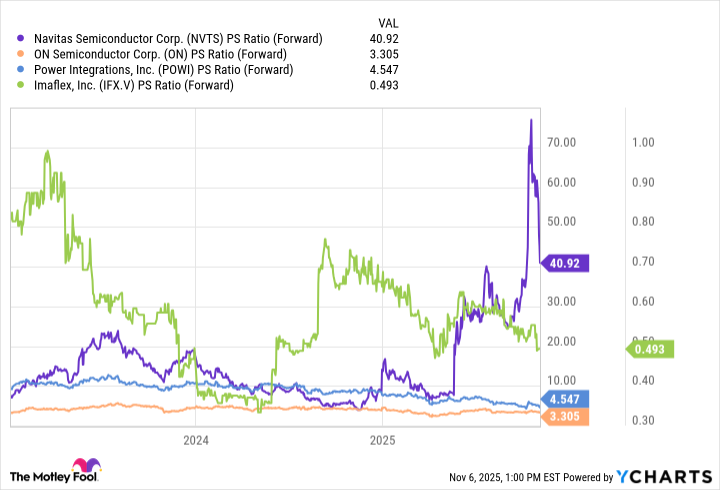Shares of Navitas Semiconductor (NVTS 3.04%) have soared 284% over the past 12 months, as investors have loaded up on tech stocks that could benefit from the artificial intelligence (AI) boom. In May, the share price rocketed 164% higher in a single day, on news that Navitas is developing cutting-edge semiconductor technology to support Nvidia's new high-voltage power system for data centers.
But the chipmaker's third-quarter results were a reality check. Navitas shares have tumbled 27% since the company reported a steep drop in third-quarter revenue and a widening net loss. With the stock continuing to drift lower as of this writing, is this a golden opportunity to pick up cheaper shares before Navitas gets its mojo back? Or was the dreadful quarter a glaring red flag warning investors to stay away?

Image source: Getty Images.
"Navitas 2.0"
Founded in 2014, Navitas describes itself as "the only pure-play, next-generation power-semiconductor company." Navitas uses advanced semiconductor materials -- primarily gallium nitride and silicon carbide -- to produce high-performance components for power electronics. Its components are designed to efficiently manage and convert electrical power in a variety of applications, including data centers, solar inverters, electric vehicles, medical equipment, consumer electronics, and mobile charging devices.
After several years of strong top-line growth, Navitas' revenue has been declining steadily since Q3 2024. In its most recent quarter, the drop-off shifted to a higher gear. Q3 revenue plummeted 53% to $10.1 million, while the company's net loss widened by 2.7% to $19.2 million.
The good news is that this was the old Navitas Semiconductor. In August, the company appointed semiconductor industry veteran Chris Allexandre as CEO, and Allexandre promptly unveiled a transformation plan called "Navitas 2.0." As part of Navitas 2.0, the company is pivoting away from its lower-margin consumer and mobile business -- particularly in China -- and doubling down on high-power, high-growth markets such as AI data centers, performance computing, energy, and industrial electrification.
Since assuming CEO responsibilities in September, Allexandre said that customers in Navitas' target markets have consistently told him that its gallium nitride and silicon carbide power devices "are the solution to the problem they are trying to solve and the revolution they are driving." Both gallium nitride and silicon carbide can process power faster, at higher voltages and temperatures, and in smaller form factors than silicon, the most commonly used semiconductor material.
"Our focus is on long-term engagement where technological innovation makes a difference," he said during the company's Q3 earnings call. "We believe this will ultimately drive high-quality business with greater predictability, consistency, and a higher margin."
The transformation won't happen overnight, which likely means some short-term pain for investors. Management expects revenue to bottom in the fourth quarter, and the company has declared that 2026 will be a transition year. Analysts have low expectations for 2026, with an average revenue estimate of $44 million.

NASDAQ: NVTS
Key Data Points
Should you buy the dip?
Navitas isn't profitable, although the company made some strides last year, reducing its net loss from $146 million in 2023 to $84.6 million in 2024. Exiting low-end consumer electronics markets should help improve margins, but there's no guarantee that the company will achieve profitability anytime soon.
One thing that Navitas has in its favor is a strong balance sheet. The company ended the third quarter with nearly $151 million in cash and equivalents, and no debt. Navitas is burning through $10 million to $11 million per quarter, so the company should have plenty of cash to fund its ongoing operations during the transition.
If you're wondering how an unprofitable company with rapidly declining sales can maintain such a strong cash position, it's by selling a lot of stock. Since NVTS started trading on the Nasdaq Stock Exchange in October 2021, the outstanding share count has increased by 580%. This isn't an uncommon practice by any means, but share dilution is a risk to keep in mind when you're thinking about investing in an emerging tech company like Navitas.
We can use the forward price-to-sales (P/S) ratio to get a sense of whether Navitas is undervalued. As you can see in the chart below, Navitas is trading at a premium compared to some of its peers based on this valuation metric. This tells me that the share price hasn't adjusted to the severe drop-off in sales that the company is navigating while it recalibrates for the future.
NVTS PS Ratio (Forward) data by YCharts.
Pivoting to AI data centers and other high-growth markets seems like a strong move, but it begs the question of why the company waited so long to do so. At this point, Navitas Semiconductor is a high-risk, high-reward investment, and I would steer clear of this stock until there's concrete evidence that its transformation plan is working.





